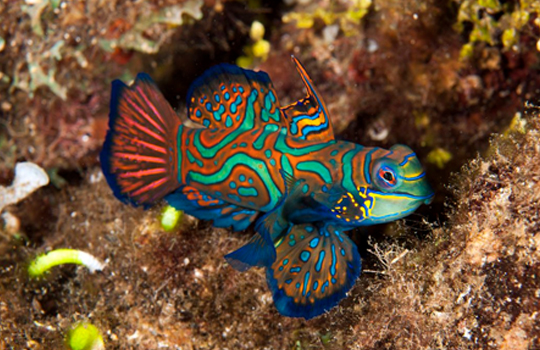Biodiversity refers to the variety of living species that can be found in a particular place. Coral reefs are believed by many to have the highest biodiversity of any ecosystem on the planet—even more than a tropical rainforest. Occupying less than one percent of the ocean floor, coral reefs are home to more than 25% of all marine life.
Why is that important? A highly biodiverse ecosystem, one with many different species, is often more resilient to changing conditions and can better withstand significant disturbances.
Each species plays its own function in a coral reef ecosystem. Some are herbivores and specialize in eating different kinds of algae, keeping corals from being smothered by their potentially deadly competitors. Others, like sharks, groupers, and other predatory fish, keep populations of smaller fish and other organisms in balance.
Parrotfish actually eat the reef itself. They scrape at the coral to get to the small algae (zooxanthellae) living inside the coral polyp, then grind up the coral skeleton with teeth in their throats and excrete it as sand. Those beautiful, white sand beaches? Thank parrotfish.
“Cleaner” fish (and shrimp) keep other fish healthy by freeing them of parasites, while crabs and sea cucumbers crawl about, scavenging and cleaning up detritus on the reef and ocean floor.
Even marine worms and snails perform important roles in the reef ecosystem. Worms filter organic matter in the water and sediments, while snails such as limpets and conchs graze on algae. The snails sometimes become food for sea stars—while sea stars can in turn be eaten by giant snails! Other creatures in the “spiny-skinned” or echinoderm family—such as feather stars and basket stars—capture plankton from the current.
Sea anemones—like the clownfish anemone—have formed symbiotic, or mutually beneficial, relationships with fish and crabs. The sea anemones hide and protect the fish and crabs while the fish and crabs in turn protect the anemones. Animals that help filter and clarify the water on a reef include sea squirts and salps (“tunicates”), and giant clams (mollusks), which sieve and eat phytoplankton. And even primitive animals like sea sponges are important to reef health, providing habitat for crustaceans, marine worms, and young fish in their intricate aquiferous canals, and for barnacles and tiny mollusks in their complex surfaces. They are also “recyclers”—taking in nutrients they filter from the water and producing waste products that feed lots of other reef species. Sponges themselves become food for nudibranchs, sea stars, turtles, and fish. And they are valuable to humans as well, producing diverse chemical compounds that are being explored for human medicines.
